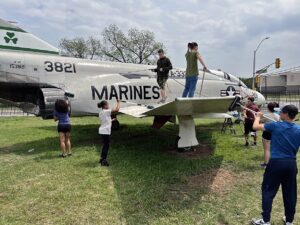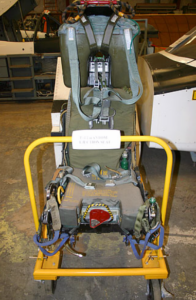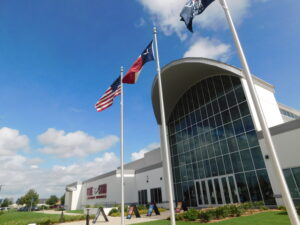Explore Texas’ Aviation Museums
From training military pilots to contributing to space exploration, Texas has played a pivotal role in aviation’s development. Across the state, aviation museums stand as living tributes to this legacy, preserving stories, artifacts and aircraft for future generations.
Four institutions — the Fort Worth Aviation Museum, the Frontiers of Flight Museum, the Lone Star Flight Museum and the Texas Air Museum — offer visitors a chance to step back in time and explore the evolution of flight. Through unique exhibits, each museum showcases a different facet of aviation’s impact on Texas and beyond, offering a chance to educate and inspire the next generation of aviation professionals.
The Fort Worth Aviation Museum’s roots trace back to the OV-10 Bronco Association, Inc., founded in 1999 to honor the legacy of the OV-10 community. Over time, the museum expanded its mission, evolving into the Forward Air Controllers Museum and Veterans Memorial Air Park before rebranding in 2014 as the Fort Worth Aviation Museum. Today, the museum focuses on aviation’s pivotal role in shaping the region, offering a one-of-a-kind experience with 36 aircraft, including the largest walk-up-and-touch warbird collection in Texas. A standout addition is a Marine Corps F/A-18, currently being demilitarized, with plans to join the museum’s collection in 2025.
The museum goes beyond planes, offering immersive educational programs from flight simulators to drone classes and outreach initiatives that take helicopters and exhibits to schools and parades across the region. Special events, such as a craft beer festival and seasonal markets, bring the community together, while the annual Texas Aviation STEM magazine reaches 2.5 million readers, fueling the next generation of aviators. Looking ahead, the museum is preparing for a significant expansion into a 110,000-square-foot facility, with the first phase opening at 25,000 square feet, ensuring it continues to inspire and engage for years to come.
Frontiers of Flight Museum:
 The Frontiers of Flight Museum’s journey began in 1963 when George Haddaway donated his extensive aviation collection to the University of Texas. Decades later, it found its permanent home at Dallas Love Field, which has become a global destination, drawing 158,000 visitors annually from 49 countries. With a team of multilingual volunteers, the museum offers a welcoming atmosphere for guests of all ages.
The Frontiers of Flight Museum’s journey began in 1963 when George Haddaway donated his extensive aviation collection to the University of Texas. Decades later, it found its permanent home at Dallas Love Field, which has become a global destination, drawing 158,000 visitors annually from 49 countries. With a team of multilingual volunteers, the museum offers a welcoming atmosphere for guests of all ages.
The museum’s exhibits highlight aviation and aerospace history, featuring iconic artifacts like the Apollo 7, the rare Pancake Spy Plane and the SR-71 Blackbird. With displays spanning early aviation, military aircraft, space exploration and Southwest Airlines’ history, there’s something for everyone. The museum’s educational programs, including STEM initiatives, field trip opportunities and scout programs, inspire future aviation and aerospace professionals. Hosting various family-friendly events, fundraisers and guided tours, the museum serves as a hub for the community. Looking ahead, the museum’s Destination: Frontiers initiative will continue to transform the visitor experience with a renovated store featuring a new coffee bar and the addition of an innovation lab onsite, solidifying its commitment to education and innovation.
Lone Star Flight Museum:
 The Lone Star Flight Museum (LSFM) opened in 1990 at Scholes Field in Galveston, Texas, with founder Robert Waltrip’s vision of showcasing his historic aircraft collection. In 2017, the museum relocated to Ellington Airport in Houston, marking the transformation of the flight museum and a world-class STEM learning center. Its mission is to celebrate flight and achievement in Texas aviation history and educate and engage our youth through STEM.
The Lone Star Flight Museum (LSFM) opened in 1990 at Scholes Field in Galveston, Texas, with founder Robert Waltrip’s vision of showcasing his historic aircraft collection. In 2017, the museum relocated to Ellington Airport in Houston, marking the transformation of the flight museum and a world-class STEM learning center. Its mission is to celebrate flight and achievement in Texas aviation history and educate and engage our youth through STEM.
With nearly 30 aircraft on display, including the North American B-25 Mitchell — the only flying B-25 painted in the colors of the Doolittle Raider — LSFM offers visitors a unique connection to history. Exhibits like the Texas Aviation Hall of Fame, the Flight Academy and the Space Gallery immerse visitors in aviation and the science of flight. Interactive experiences such as flight simulators, the MAKER! Hands-on STEM Learning series and the Boeing Toddler Terminal engage all ages, while the museum’s outreach programs, including mobile flight simulators and partnerships with schools, extend its impact. Signature events like Girls in Aviation Day and Hangar Bash bring the community together, and fundraising efforts support the museum’s public and educational programs. Looking ahead, LSFM is expanding its educational initiatives with programs like ACES that give students hands-on opportunities to explore aviation careers and build aircraft. The museum remains committed to inspiring future aviators and preserving Texas’ aviation legacy.
Texas Air Museum:
 The Texas Air Museum Stinson Chapter, founded in 1999 by John Douglas Tosh, is located at the historic Stinson Field in San Antonio, the second-oldest general aviation airport in the United States. Part of the Texas Air Museum network, the Stinson Chapter preserves artifacts from early aviation through modern aerospace achievements, with a focus on World War I and World War II and San Antonio’s pivotal role in aviation history. Notable exhibits include a 1910 Curtiss Model D, military aircraft like the F-4 Phantom and a historic helicopter, along with displays on space exploration and a tribute wall honoring Texas pilots from both World Wars.
The Texas Air Museum Stinson Chapter, founded in 1999 by John Douglas Tosh, is located at the historic Stinson Field in San Antonio, the second-oldest general aviation airport in the United States. Part of the Texas Air Museum network, the Stinson Chapter preserves artifacts from early aviation through modern aerospace achievements, with a focus on World War I and World War II and San Antonio’s pivotal role in aviation history. Notable exhibits include a 1910 Curtiss Model D, military aircraft like the F-4 Phantom and a historic helicopter, along with displays on space exploration and a tribute wall honoring Texas pilots from both World Wars.
Honoring the legacy of pioneering aviators Katherine and Marjorie Stinson, founders of Stinson Field, the museum showcases the history of the flight school and the women pilots who trained there. Recent updates, including history panels reconstructed by H-E-B, enhance the exhibits, offering visitors a deeper connection to the past. Each year, the museum welcomes around 5,000–6,000 visitors, from aviation enthusiasts to high school Air Force ROTC students taking guided tours. Hands-on experiences, like sitting in a T-37 cockpit simulator, bring history to life, while community events — including Memorial Day and Veterans Day observances and the annual Ugly Christmas Sweater Day — make the museum a gathering place beyond its exhibits. Looking ahead, efforts to restore aircraft from the 1920s and 1930s reflect the museum’s ongoing mission to preserve aviation history and inspire future generations.
Whether you’re a history buff, a lifelong aviation enthusiast or someone seeking a unique day out, these museums invite you to explore the magic of flight. As stewards of Texas’ aviation history, they ensure the state’s contributions to the skies will never be forgotten — and they stand ready to inspire the next generation to take to the air.







